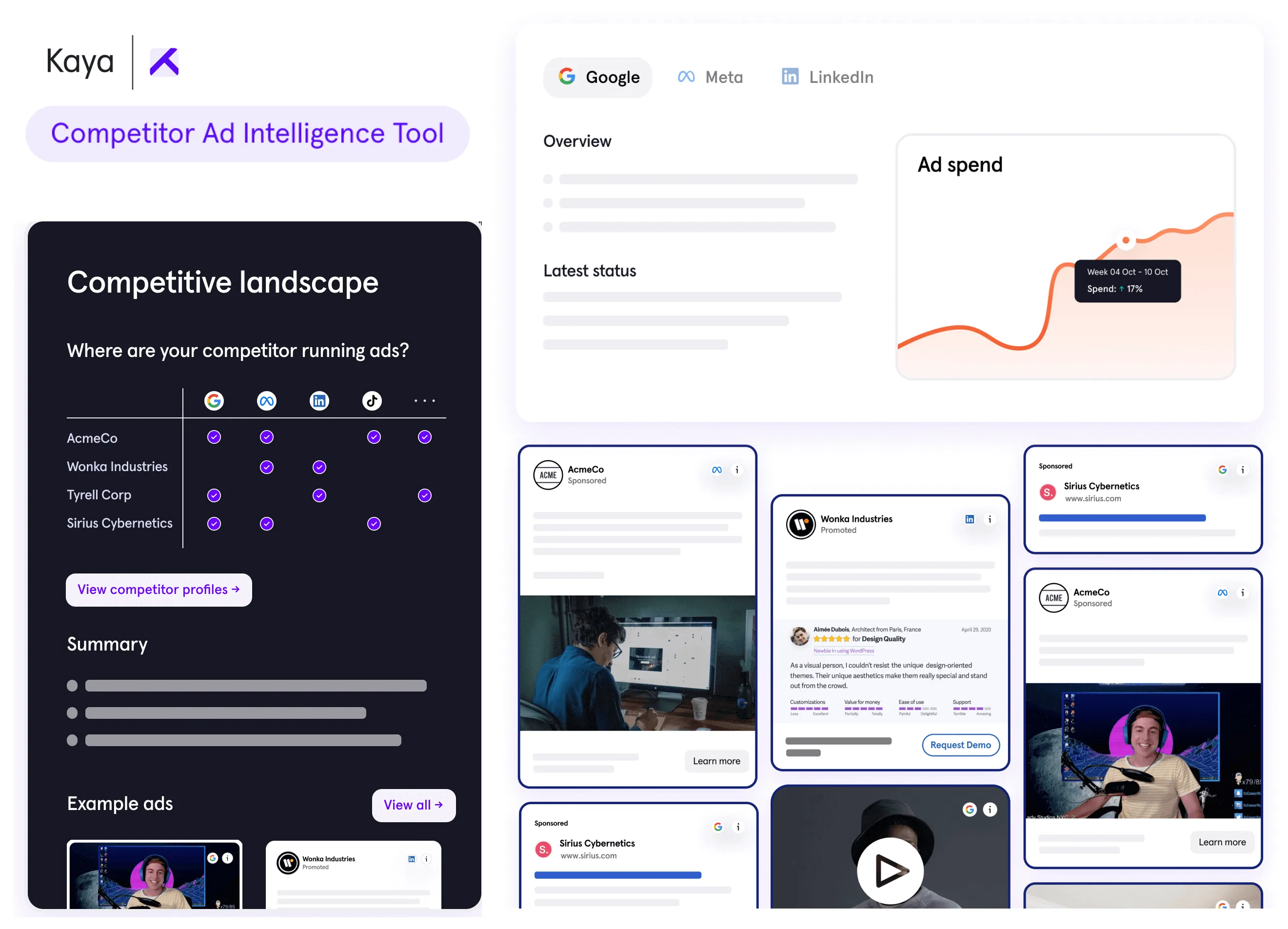According to statistics, digital advertising spending should reach $870.85 billion by 2027. As you invest in ads, you want to get the best ROI within the quickest time possible. Analyzing your competitor’s ads allows you to fine-tune yours and make the most of your investment.
So, an in-depth competitor analysis is vital to stay on top of marketing activities. Keep reading to see our top tools for finding competitor ads, their features, pricing, and applications. By the end of this post, you'd have learnt about:
- The importance of finding competitor ads
- Primary tools for finding competitor ads
- Choosing the right tool to find competitor ads
- How to find and analyze competitor ad strategies
What are competitor ads?
Competitor ads are paid campaigns run by businesses in your niche across platforms like Google, Facebook, LinkedIn, TikTok, or YouTube. They aim to capture the same audience you’re targeting, using creative formats such as search ads, video ads, or carousel posts.
How to research competitor ads
To research competitor ads effectively, start by identifying your top competitors and the channels they’re active on — like Google, Facebook, LinkedIn, or TikTok. Use tools such as SEMrush, Adbeat, Meta Ads Library, or Google Ads Transparency Center to find their paid campaigns (we break these down later in the blog).
Focus on uncovering patterns in ad creatives, messaging, CTAs, and landing page strategy. Look at what they’re promoting, how often, and to whom. This helps you understand their funnel and positioning. The goal isn’t to copy, but to reverse-engineer what’s working and find strategic gaps your brand can capitalize on.
The importance of finding competitor ads
Kaya, Semrush, Ahrefs, AdBeat, SpyFu, and AdEspresso all offer efficient tools to find and analyze competitor ads. But why is that necessary? Competitor ad analysis allows you to identify strategies used by competitors in their ad campaigns to improve your performance. You can enjoy other benefits, such as;
Understanding the market and trends
When you find competitor ads, you can analyze them to identify the products and services that your target customers want. It lets you know what keywords buyers are searching for. That helps you understand market trends.
Developing better products
When you find and analyze competitor keywords, you gain insights into market demands, which helps you deliver better products and services in line with consumer demands.
Creating better marketing
When you perform an ad analysis, you can discover your competitor’s marketing strategies and methods. This helps you develop better marketing solutions than theirs.
Beyond CTR and conversions, analyzing competitor ads also helps you uncover critical performance indicators like cost per acquisition (CPA), return on ad spend (ROAS), and impression share. These metrics reveal not just what’s working for your competitors, but how efficiently their campaigns are performing, giving you benchmarks to beat.
Paid tools for finding competitor ads
The table below outlines key features of popular competitor ad analysis tools. Use this to select the best fit for your needs based on factors like pricing, data depth, and ease of use.
If you're looking for an all-in-one solution for finding competitor ads, Kaya's Competitor Ad Intelligence Tool is the best value for money. At an affordable price point, you get an extensive coverage of data and insights on your competitors' ad spend and creatives across all major ad platforms. Alternatively, you may also consider Spyfu or SEMRush but both lack the coverage for Paid Social ads.
| Core Functionality | Pricing | Data Availability | Value Added Features | |
|---|---|---|---|---|
| Kaya |
|
Low Best value for money as Paid Social and Ad Spend data is included From $100 |
Covers past 1 year of data; with actionable insights by experienced marketing strategists and AI |
|
| SEMrush |
|
High Expensive for startups, limited features in lower tiers From $139.95/month |
Historical data is not available for lowest tier | Content marketing tools available for higher tiers |
| AdBeat |
|
High Expensive for startups, limited data for the lowest tier. Ad spend data only for Enterprise tier From $249/month |
Limited to 90 days of historical data for the lowest tier | See advertising data from display and native ad networks |
| Ahrefs |
|
Mid Limited features in lower tiers From $129/month |
Limited to 6 months of historical data | Keyword and Site Explorer |
| SpyFu |
|
Low Suitable for Paid Search starters From $39/month |
Limited to 6 months of historical data for the lowest tier | Custom reporting available |
| iSpionage |
|
Mid Limited features in lower tiers From $59/month |
Limited to 3 months of historical data for the lowest tier | PPC campaign watch |
1. All-in-one solution with actionable insights: Kaya's Competitor Ad Intelligence Tool
Every competitor ad tool offers various types and levels of data, but most do not organize it in a simple way that eases and supports fast decision-making. This is where Kaya’s Competitor Ad Intelligence Tool makes the most difference.

With Kaya's competitor ad intelligence tool, get a bird's eye view on your competitors' Google ads, Meta ads, LinkedIn ads and more.
Aside from automating all your competitors' ads tracking across platforms like Google ads, Meta ads and LinkedIn ads, it offers actionable insights on your ideal customer profile and messaging that resonates with them.
It also recommends suitable ad channels and ideal investment. The ad intelligence tool collects all the data in one place, giving you a single source of truth for your ad strategy.
Through the ad intelligence tool, Kaya has managed over $8M in ad spend and saved teams over 5 hours weekly. It continues to deliver strong marketing ROI for startups backed by world-class investors like Y Combinator, Sequoia Capital, a16z, Google’s Gradient Ventures. Startups including Rippling, Encord, Strive, AirGarage and Venn have trusted Kaya as their marketing partner to grow 10x better and faster.
2. SEMrush
SEMRush offers a tool to analyze SEO, PPC, content marketing, and social media performance. It has an advertising research section where you can find and analyze competitor ads. SEMrush offers insights on ad positions and changes, competitors, ad copies, and ad history. It also shows competitors’ ad strategies and budgets. You can filter the data by keyword trends and traffic cost. It offers three monthly plans:
- Pro plan for $139.95
- Guru plan for $249.95
- Business plan for $499.95
It is a popular tool with an up-to-date database and a free trial offer. However, SEMrush offers limited features for the free trial version, and its pricing is expensive, making it unsuitable for startups.
3. AdBeat
Adbeat is a competitive intelligence tool for display ads. It allows you to see your competitor’s entire ad strategy. It also shows competitor ad formats, such as display, video, and native ads. It also shows how competitors use their ads, how they buy ad space and traffic from multiple ad networks. It supports alerts and reveals top creatives, media buying strategies, landing pages, and estimated ad spend. Adbeat offers two paid monthly plans:
- Standard plan for $249
- Advanced plan for $399
There is an enterprise plan, but interested organizations have to call to get a quotation. AdBeat does not have a trial offer, making it expensive for startups and small businesses.
4. Ahrefs
Ahrefs is an SEO and paid search analysis tool for competitor ads. It has features for finding traffic volume and its value. It also allows you to see competitors' paid keywords and which ads and landing pages are bringing in traffic. Ahrefs offers five plans, as follows:
- Lite plan for $129/month
- Standard plan for $249/month
- Advanced plan for $449/month
- Enterprise plan for $14,990/year
Despite its many features, it is difficult to use and does not provide a central data interface. Also, although the starter plan is affordable, it offers very limited features that do not move the needle for competitor ad analysis.
5. SpyFu
SpyFu is a competitor tracking tool that offers keyword analysis and PPC spying. It also curates a dashboard with graphs, and the insights can be filtered to offer details on paid clicks, the number of paid keywords, and the estimated ad budgets of each competitor. They offer several tiers of paid services for monthly or yearly plans, as follows:
- Basic plan for $39/month
- PRO plan for $79/month
Spyfu allows you to see your competitor's keywords. It also offers insights into your competitor's best and least-performing ads. Although a powerful tool for competitor ad research, its graphs are not user-friendly, and users have reported inaccurate data.
6. iSpionage
iSpionage analyzes multiple aspects of competitor PPC campaigns, such as the number of targeted keywords and the actual PPC keywords. It also has features for viewing PPC ads competitors for various topics and projected budgets. It also shows your top Google ads competitors, how much they budget monthly, and their entire PPC strategy. They offer four membership tiers, as follows:
- Starter plan for $59/month
- Professional plan for $99/month
- Advanced plan for $299/month
- Custom enterprise solution
Despite its many features, reviews describe it as less agency-friendly, and it has a limited database. Plus, the $59 for limited features may not deliver quick results for startups.
How to choose the right tool to find competitor ads
As a best practice, you may combine several tools to get the highest benefits, but what makes an ad intelligence tool the right one for you?
Factors to consider when spying on your competitor’s ads
When comparing tools, look at:
- Platform coverage: Does it include Google, Meta, LinkedIn, TikTok, YouTube?
- Metrics depth: Beyond clicks and impressions, does it show ROAS, CPA, CTR, conversion rates?
- Automation & alerts: Can you set tracking alerts, receive AI-powered insights, or monthly digests?
- Data exports & dashboards: Does it support CSV exports, Slack summaries, or Looker Studio integration?
- Integration capabilities: Connects with GA4, HubSpot, Mixpanel, or Zapier?
How to find and analyze competitor ad strategies
You may wonder how to analyze competitor ad strategies with these tools. We created a helpful guide to achieve this. Here is a high-level guide to finding and analyzing competitor ad strategies.
1. Identify and segment your competitors
Start by mapping out your direct and indirect competitors. Direct competitors offer similar products to the same audience, while indirect ones compete for attention, not necessarily with the same solution. Use keyword research, Google searches, ad libraries, review sites, and customer conversations to uncover who’s showing up in your niche and who’s capturing mindshare even if they’re not obvious players.
2. Collect ad data across platforms
Use tools like Kaya, Meta Ads Library, TikTok Creative Center, and SEMrush to track competitor ads across Google, Meta, LinkedIn, and more. Export creatives, observe ad types (video, carousel, static), and take note of posting frequency and timing. Don’t just limit yourself to active ads. Look at historical trends to understand how campaigns evolve across platforms and seasons.
3. Decode targeting and funnel strategy
Once you’ve collected ad examples, examine the deeper layers. Are they targeting broad or niche audiences? Do their ads vary by location or device? Are they running different formats across platforms, or simply repurposing? Click through to their landing pages and assess the user journey such as short-form lead gen, gated content, long-form conversion pages. If creatives show variation in messaging or CTA, that’s often a sign of structured A/B testing.
4. Evaluate performance benchmarks
If your tool supports it, pull estimated metrics like CTR, conversion rate, CPA, ROAS, and impression share. Are they increasing spend but seeing lower performance? Are they dominating a platform but ignoring others? These insights help you understand not just what your competitors are doing, but how well it’s working and where your opportunity lies.
5. Turn insights into strategic experiments
Use your findings to build smarter campaigns. You might test similar messaging with a differentiated CTA, double down on underutilized platforms, or build creative angles their ads are missing. Don’t forget to set up alerts for future competitor campaigns. Staying reactive and agile can give you a consistent edge as the landscape shifts.
Case studies
Abbot
Abbot was not getting the desired results from their marketing and reached out to Kaya. Through a mix of advanced analytics and marketing automation, Kaya improved Abbot’s marketing outcomes.
Kaya has been helping us out with some marketing as well, and they have been AMAZING to work with. Highly recommend talking to them!
FAQ
How do you find competitor paid ads?
Which tool is best for competitor analysis?
Which is the tool to spy on competitor ads?
How often should I analyze competitor ads?
How can I ensure the insights from competitor ads improve my campaigns?
What is an example of a competitor ad and a competitor ad campaign?
Final thoughts
Gaining in-depth insight into competitor ads can help you create a better marketing strategy. When you evaluate their ad performances, you can get more insights into what works and what does not.
Using paid tools to find competitor ads gives you access to features that may not be present in free tools. However, most ad intelligence tools still do not structure data in one place—and this is one of the main advantages of Kaya’s Competitve Ad Intelligence Tool. It integrates all your marketing analytics and gives you an automated dashboard view, which eases your decision-making.




